In a world where user experience has become everything for digital businesses, can AR help reshape the e-commerce landscape?
Updated 26 October 2021

CTO at Appventurez
The growth in the e-commerce industry is drastically moving in an upward direction, especially after the integration of state-of-the-art technologies in the marketing channels. The use of digital solutions like augmented reality has completely transformed the e-commerce market, offering consumers an immersive experience more than ever before.
The implementation of augmented reality in e-commerce has bridged the gap between consumers and digital shopping stores. A gap that had widened even more after the pandemic, restricting them from physically visiting the shopping complexes and buying their favorite products.
From a business perspective, the use of augmented reality in e-commerce has been a profitable move, especially when 71% of consumers prefer shopping with retailers offering AR-based experiences. These AR applications provide your customers with a more comprehensive and deeper understanding of your products and services, even from the comfort of their homes.
The concept of AR seems futuristic; however, it was already in use for marketing purposes way back in 2008. It all started when BMW leveraged augmented reality in its marketing and advertising campaigns. However, this forward-thinking project was quite new for that generation. That’s why it couldn’t achieve the success it was expected to acquire.
Then in 2016, Niantic’s Pokémon GO took the entire commercial potential of AR by storm. This AR-based mobile gaming application captured a massive audience with its advanced functionalities. Businesses such as cafes, hotels, and restaurants tried to make themselves added as ‘Pokemon gyms and Pokestops’ in the hope to be seen by a large customer base.
Later, during the pandemic, a significant section of US-based e-commerce retailers replaced their physical channels with online portals in just three months. It was so surprising that the entire e-commerce market witnessed the growth equivalent to a whole decade in just a quarter!
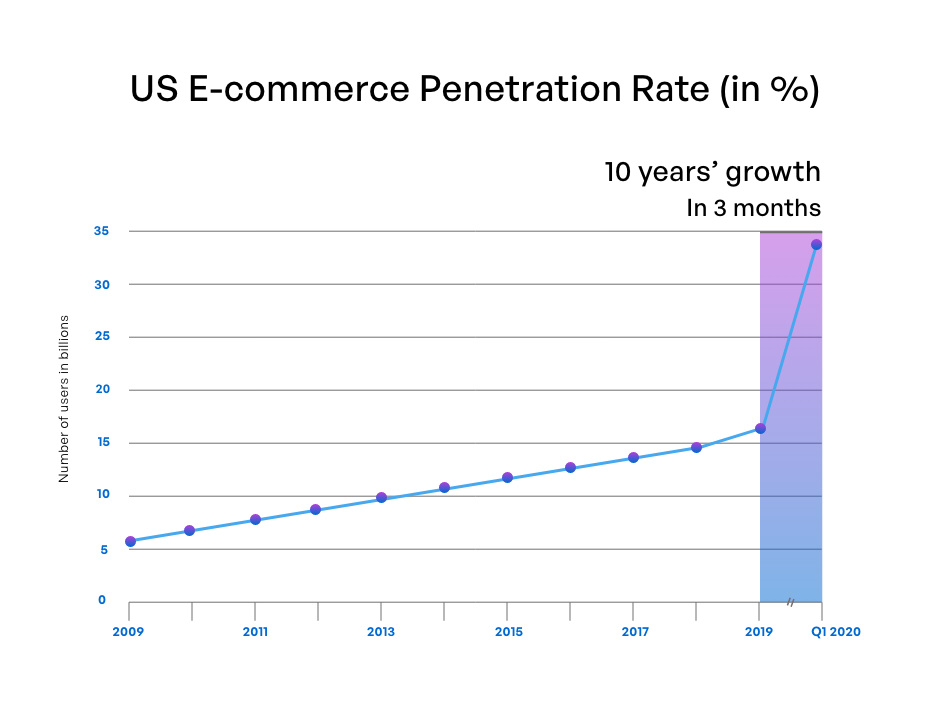
In fact, during that period, over half of the e-commerce consumers indicated that AR-based shopping has been really important to them since the beginning of the pandemic. From the retailers’ perspective, many of them observed as much as 200% sales growth after integrating AR-based solutions.
Google found that out of ten people, six of them want to visualize how and where a product would fit into their lives. The power of augmented reality brings e-commerce products to life by offering a real-life experience to customers. The following section highlights some of the notable benefits of augmented reality in e-commerce:
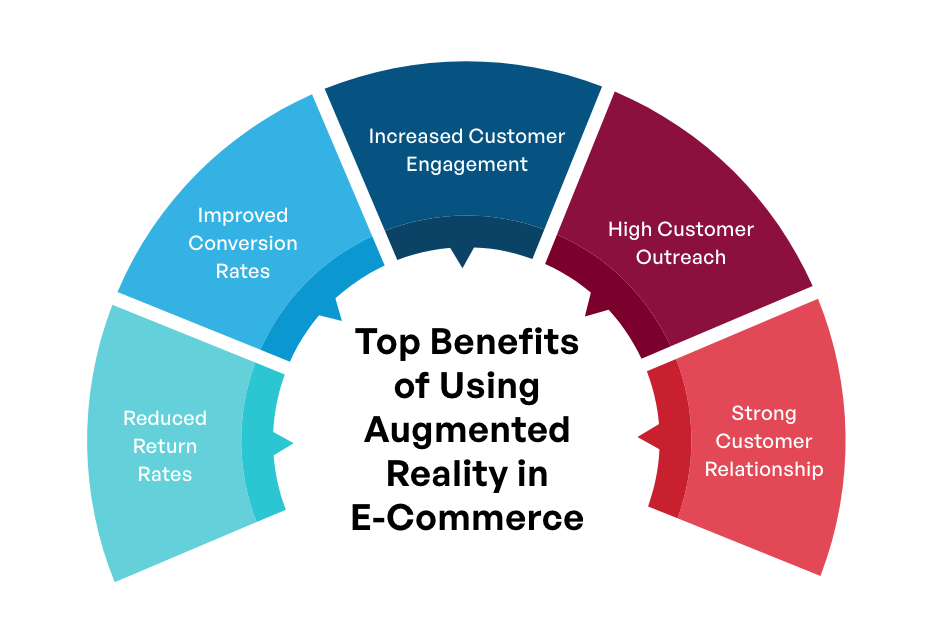
Any customer prefers a website or application only when it is interactive enough while using it. When you offer an immersive customer experience, there is a maximum chance that they will get hooked to your e-commerce portal.
Since the longer they stay on your shopping platform, the greater the possibility of them making a purchase. Even if they don’t buy instantly during the visit, a great customer experience will help enhance the engagement and relationship with your brand.
Since augmented reality in e-commerce follows a “try before you buy” approach, the customers can easily feel the product to be right there. For various industries, especially beauty, fashion, and home decor, AR has been a real game changer.
Today, one of the biggest challenges for e-commerce companies is getting customers’ attention in the competitive market. In such a scenario, creating attractive AR campaigns can significantly make things better. Since the impact of AR in mobile application development and marketing activities is easily visible, industries ranging from education to healthcare are also leveraging its capabilities.
IKEA is one of the prime augmented reality marketing examples in this category that uses AR-based campaigns to target new users and enhance their shopping experience. Its mobile application ‘Ikea’s Place App’ joined hands with Apple for its ARkit in 2017. With this portal, users can virtually place furniture from IKEA anywhere around their home or office.
Besides this, Apple also includes AR in its latest features and updates to improve the shopping experience, helping brands target and attract new users.
The intuitive and seamless shopping experience offered by AR not only helps engage the customers but also builds long-lasting relationships with them. When e-commerce brands deliver the same products and services to customers as they show while providing an AR experience, the customers start trusting in the brand more. Ultimately, it enhances brand loyalty and results in better conversion rates.
Moreover, AR also has a great ability to improve consumers’ memory which produces more comprehensive responses from their end. Simply put, it helps your customers to remember your brand and return to shop for their desired products.
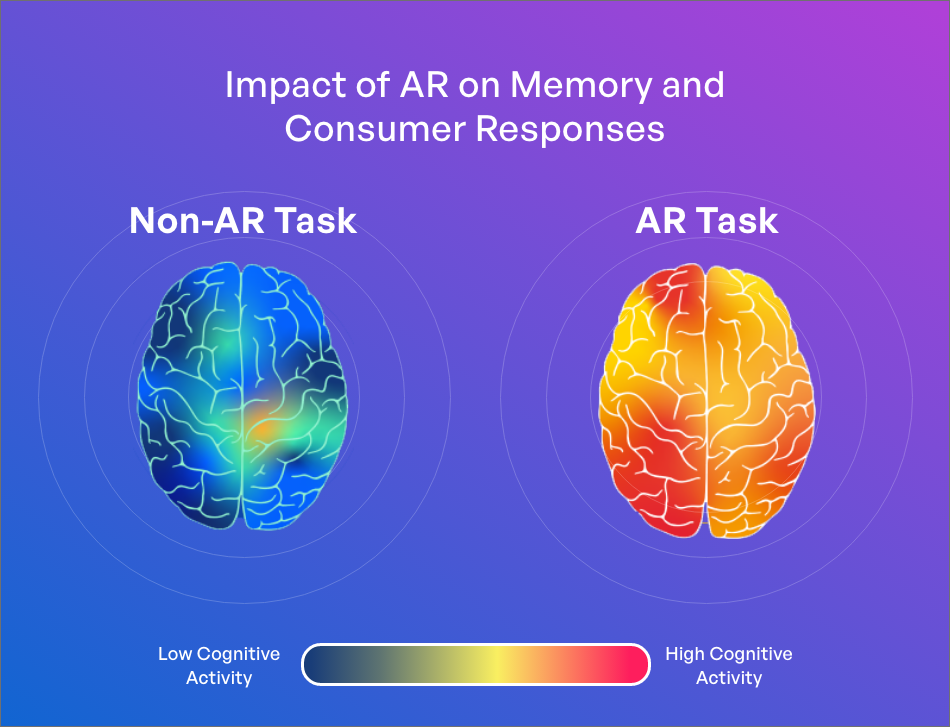
Various studies have claimed that AR in e-commerce is not only effective in improving customer engagement but also in increasing conversions on a large scale. In fact, it is reported that brands that used AR/VR for advertising their products observed 94% higher conversion rates.
For instance, Vertebrae, Facebook’s AR partner, claimed that consumer conversion rates rose by 90% more for customers engaging with augmented reality than those who don’t.
One of the biggest challenges e-commerce businesses face is high return rates. Customers often end up returning their products right after they get delivered. But do you know why?
Well, several studies analyzed that the primary reason is incorrect sizing, fitting, or design of the products, especially in the case of clothes or other related accessories. However, this is closely followed by quality issues and products being different than what they are specified. Since the customers do not get the products as they are described, consumers have no choice but to end up returning them.
The illustration below shows the top reasons why consumers in the US and UK region returned their products last year purchased through e-commerce channels.
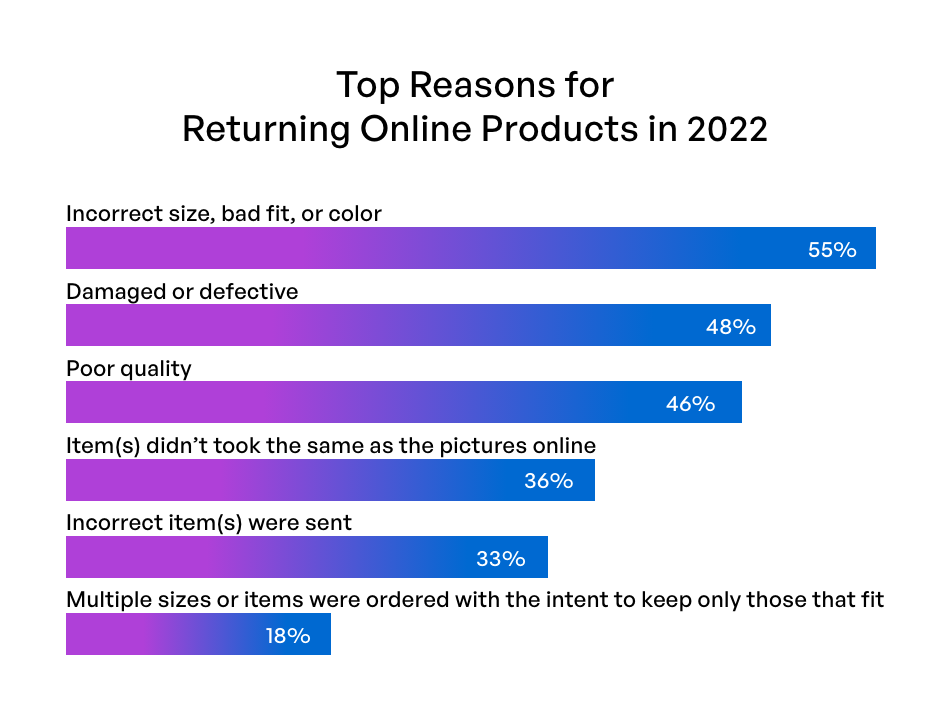
However, augmented reality can make a difference here. It allows your customers to virtually use the products and get a comprehensive understanding of them. Providing them with 3D views helps them understand how a product will look in their space, something that a static image or short video couldn’t describe. Ultimately, it gives them more confidence while making a decision to purchase.
Based on the types of AR technologies used, there could be different capabilities of AR-based applications. Here are the major types of AR applications businesses can consider for e-commerce operations:
This type of AR application identifies an object (or marker) using the camera of a smart device and offers information regarding it on the screen. Since it recognizes the image of the object, it is also known as Image Recognition or Recognition-based AR.
Once the marker is detected, these marker-based AR apps replace it with a three-dimensional version of the same object. The users can then look at the object with a more detailed view and from different angles, as well.
A markerless AR application works opposite to marker-based AR and does not need to be prompted by any object. In these apps, users can simply place an object virtually anywhere they desire. They can then easily rotate or move it for a better understanding.
Markerless AR has further divided into two categories:
It is a type of markerless augmented reality that relies on geographic positioning to show digital content to users at specific locations. Top AR-based games like Pokémon GO could be the most popular location-based augmented reality examples.
This type of markerless AR requires a specific procedure in which a synthetic light is projected onto physical surfaces, like a hologram. In several cases, users can interact with them and understand the specifications of the object. Several sci-fi movies, such as Star Wars have used the same kind of technology.
Making a purchase decision relies on several aspects. One of the crucial ones is ensuring that the particular product consumers are thinking about will fulfill their needs. AR helps them get a preview of the products and experience the services that ease the decision-making process for them. Moreover, it can also help them pick the right option in the first place, even at their own comfortable time and place. Here are a few augmented reality trends for e-commerce businesses to look for in 2023:
When you go out shopping, you might have seen an outfit worn by a mannequin and wondered how great it looked. However, when you try it on, the fit or color could be disappointing and might not look as good as it appeared earlier.
Well, this disappointment in online shopping can significantly reduce conversion rates. Since consumers are always curious about what they are purchasing and what they will actually get, it becomes crucial to provide them with the right information. In such a case, virtual try-on solutions powered by AR could be a great option.
Product demonstrations through virtual try-on are most used in the beauty, fashion, and lifestyle industries. In fact, a survey reported that more than half of the respondents find AR the best way to try on new makeup, hair colors, dresses, shoes, and other accessories.
Companies like L’Oreal, Warby Parker, and Lenskart are already offering their customers virtual try-on features for a better understanding of their products.
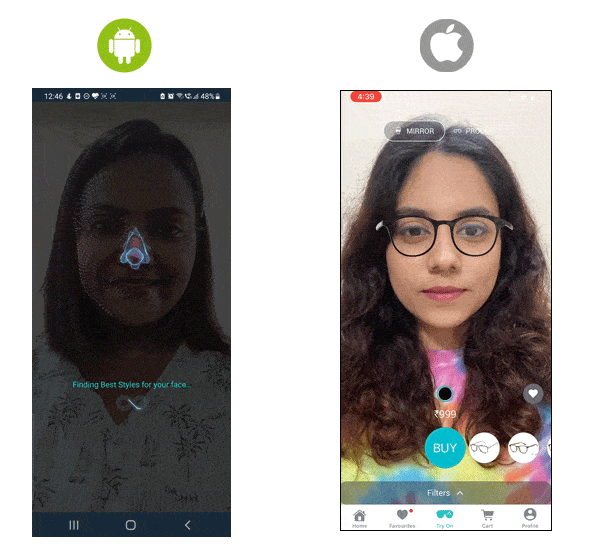
One of the things that consumers care about while purchasing bigger products, like a television, sofa set, or refrigerator is how it would look in their homes. In fact, this could be challenging to tell even when you go shopping in the brick and mortar stores.
With the object preview placement feature, you can virtually place any object in your living room, bedroom, or kitchen. It provides you with a real-time glimpse of how a product will look in your preferred surroundings.
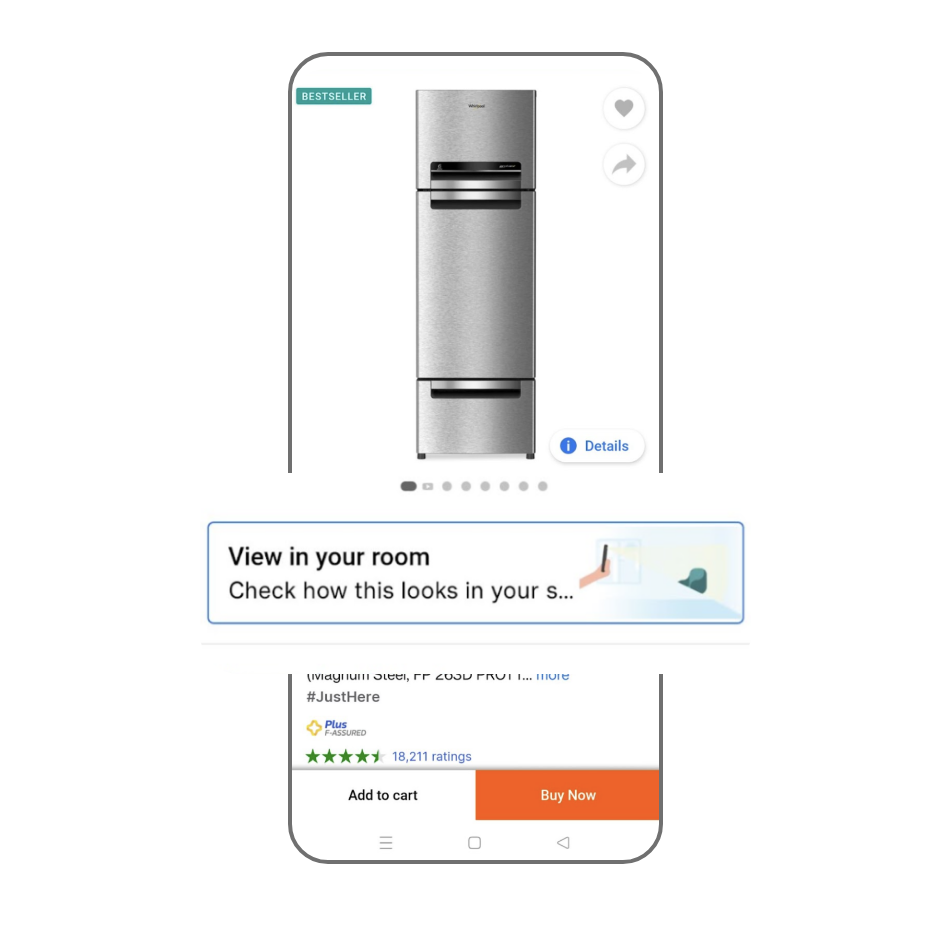
Direct-to-consumer brands like Burrow and IKEA are some popular augmented reality e-commerce examples. The ARkits integrated into the mobile app platforms of these brands help the consumers visualize how their couches and furniture would look in real time.
This is one of the most trending and easiest ways through which brands can connect with their customers and advertise their products. Since social media users are growing at an unprecedented rate every day, integrating and discovering the power of AR using them could be highly productive.
Some of the most popular platforms include Snapchat and Instagram since they enable brands to create interactive AR filters for their products and services. Social media users can use these filters to virtually interact and use the products. The most popular augmented reality advertising example is a collaboration between Christian Dior and Snapchat. The luxury brand in its 2021 marketing campaign used Instagram and Snapchat filters to motivate “virtual word of mouth”. The campaign proved to be highly successful – receiving more than 1.3 million impressions.
There is no doubt that AR is transforming the shopping experience for consumers at an ultimate level. The uses of augmented reality in e-commerce businesses are also significantly increasing, especially for those categories of products that are fairly challenging to present and sell.
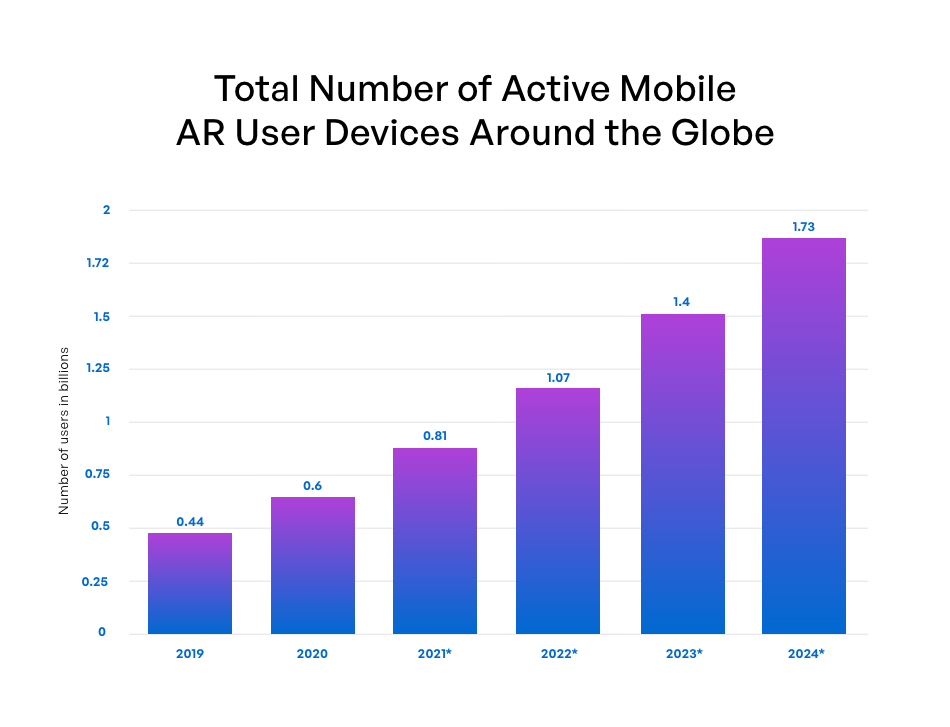
Before the implementation of AR in marketing, the products’ return rates were quite high as they failed to meet the customers’ expectations. However, things changed with AR as the consumers could easily try or interact with the products virtually before purchasing them, helping them make a fair decision.
The benefits of AR in e-commerce are right on the table, and they are constantly revolutionizing the lives of consumers extensively. And today, the significance of AR is not limited to just pre-purchase, but the advanced AR tools can help customers with post-purchase services as well. IKEA, being one of the most common augmented reality business examples, is already helping its customers with unboxing and installing products with its AssembleAR app.
Still, it might take a few more years for AR to completely take over the market of online shopping. However, when extended reality has paved its path in the market, an already accepted technology like AR wouldn’t take too long to become mainstream. Also, the way it is capturing the attention of a massive audience does convey that the future is bright for AR in the online shopping space.
No matter how wonderful your product or service is, at the end of the day, everything narrows down to the fact that how much your customers approve of it. Since customer satisfaction becomes the priority, businesses have to implement customer-oriented solutions like AR in order to provide them with an immersive shopping experience.
Now, since you are familiar with the types of AR apps and the benefits associated with them, you can easily evaluate what kind will be the best for your business. However, if you still have doubts or need help with developing AR-based solutions, Appventurez has got your back.
We, as a software development company, are well-versed in augmented reality development practices. Our team of experienced developers not only builds reliable AR mobile apps or platforms for your business but also walks you through the process for better understanding.
So, if you want to enhance your marketing campaigns, it’s the right time to become part of this new normal and bring life to your products with the power of augmented reality.
Ans. By using augmented reality in e-commerce, businesses can provide their customers with an option to virtually try the products before buying them. This way they can interact with the goods they are purchasing, and conveniently decide whether to buy them or not.
Ans. There are several benefits of using augmented reality in e-commerce businesses, such as improving user engagement and experience. Besides this, AR can also help in increasing conversion rates and reducing order cancellations and product returns.
Ans. Today, most brands are using AR for marketing and promotional purposes. Some popular augmented reality advertising examples are Nike, which uses AR for product promotional campaigns. Other than that Dior, Verizon, and Sony are also leveraging augmented reality for enhancing brand awareness and marketing activities.
{
“@context”: “https://schema.org”,
“@type”: “VideoObject”,
“name”: “https://www.appventurez.com/wp-content/uploads/2021/10/product-demonstration-through-virtual-try-on-solutions-2.gif”,
“description”: “product demonstration through virtual try on solutions”,
“thumbnailUrl”: [
“https://www.appventurez.com/wp-content/uploads/2023/03/Screenshot-from-2023-03-15-17-27-50-1.png”
],
“uploadDate”: “2023-03-15”,
“contentUrl”: “https://www.appventurez.com/wp-content/uploads/2021/10/product-demonstration-through-virtual-try-on-solutions-2.gif”,
“publisher”: {
“@type”: “Organization”,
“name”: “Appventurez”,
“logo”: {
“@type”: “ImageObject”,
“url”: “https://cdn-gemlf.nitrocdn.com/fnohFJpHJdCNUlifNxvjlylKxrRrBZKg/assets/images/optimized/rev-429bb30/wp-content/uploads/2023/02/AV-Logo.svg”,
“width”: “”,
“height”: “”
}
},
“duration”: “PT0M4S”
}


Elevate your journey and empower your choices with our insightful guidance.

CTO at Appventurez
CTO and Co-Founder at Appventurez, Sitaram Sharma has 10+ years of experience in providing world-class digital solutions. As a CTO, he brought his expertise ranging from product enhancements to advanced technological integrations, while focusing on the consistent growth of the team.
Posted : 26 October 2021